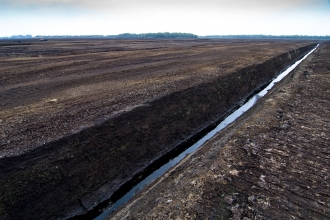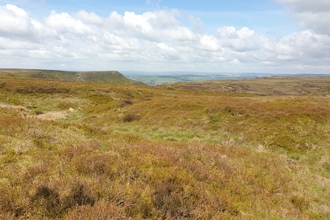Across Lancashire, Manchester and North Merseyside we have lost 98 per cent of our lowland raised peat bogs, and it is estimated that around 80 per cent of English peatlands have been damaged.
What happened to our peatlands?
For years peatlands were seen as wastelands whose only value was when they were drained and the peat extracted. For example, when Daniel Defoe visited the once extensive Chat Moss peatland of Greater Manchester in 1726 he was certainly not impressed;
‘On the road to Manchester, we passed the great bog or waste called Chatmos... What nature meant by such a useless production, tis hard to imagine; but the land is entirely waste.’
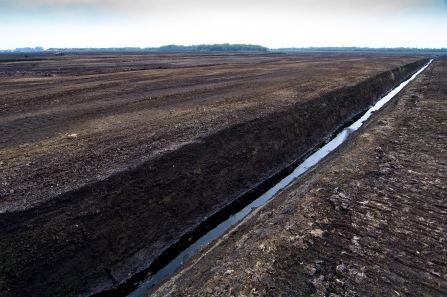
The devastation of peat extraction on Little Woolden Moss in Manchester
The most common form of damage to our peatlands is drainage, cutting deep ditches and channels into peatlands to dry them out. In some cases, the peat will then have been cut and used for fuel, or the land converted for agricultural use, managed as shooting estates, or the peat extracted for use in horticulture.
These treatments left our peatlands scarred, barren and desiccated. A far cry from the squelchy, wildlife rich, unique and important habitats that nature had spent millennia creating.
But why does this matter?
Peatlands are one of our most amazing habitats and provide us with a number of vital ecosystem services, providing a natural solution to some of our planets most pressing problems.
Carbon capture
Plugs of sphagnum moss at the Winmarleigh carbon farm
The slow partial decomposition of sphagnum mosses and other peatland plants in the water-logged anaerobic conditions of peatlands, means that the carbon that has been captured within the plants’ cells during their lifetime via photosynthesis remains trapped within the peat. In this way healthy peatlands are able to absorb carbon from the atmosphere and lock it away in their peaty soils for millennia, making peatlands one of our most important carbon stores – they cover only three per cent of our land, but hold approximately 30 per cent of terrestrial carbon!
UK peatlands are estimated to be releasing 18.5 million tonnes of greenhouse gases per annum, making up five per cent of our total climate change affecting emissions
However, as soon as a peatland is drained or damaged, that carbon gets released. In fact, UK peatlands are estimated to be releasing 18.5 million tonnes of greenhouse gases per annum, making up five per cent of our total climate change affecting emissions.
Find out how we are fighting this at our pioneering carbon farm.
Biodiversity

One of the first large heath butterflies to fly on Astley Moss in over 100 years! By Andy Hankinson
Globally we are facing a biodiversity crisis, and in the UK alone 44 per cent of species have declined, with 15 per cent facing extinction. Habitat loss is a major driver of these declines and peatlands are no exception.
Peatlands are home to lots of amazing plants and animals, including many rare and specialised species that have evolved to thrive in their boggy acidic conditions. On a visit to a healthy peatland you may be met with a plethora of plants, mammals, bird and invertebrate species, including the large heath butterfly which was successfully reintroduced to the peatlands of Greater Manchester in 2020 for the first time in over 100 years.
Natural flood mitigation
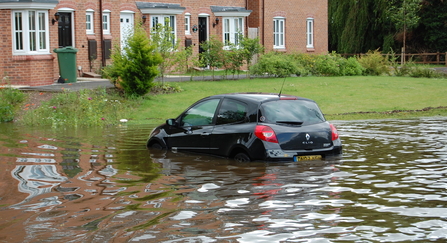
Flooding is a threat to many communities - Scott Petrek
Sphagnum moss is able to absorb up to 20 times its own weight in water, this is one of the reasons peatlands are so boggy. However, this also comes in extremely handy during storm events. Healthy peatlands will absorb rainwater, releasing it slowly downstream and helping to alleviate flood events. Whereas conversely, on drained and desiccated peatlands the water simply runs off, contributing to the extreme volumes of water that cause flooding.
Decreased wildfire risk
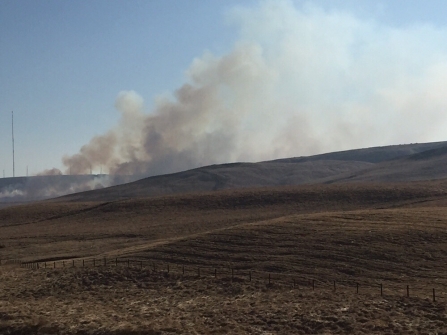
Fire in progress on Darwen Moor. Image by Alan Wright
Wildfires are becoming increasingly common, and many of these occur on damaged peatlands. This is not only catastrophic for the wildlife in these areas, including ground-nesting birds and invertebrates, but releases even more carbon into the atmosphere. For example, fires in Indonesian peat swamp forests in 2015, emitted nearly 16 million tonnes of CO2 a day. This is more than the daily emissions from the entire US economy.
Fires in Indonesian peat swamp forests in 2015, emitted nearly 16 million tonnes of CO2 a day. This is more than the daily emissions from the entire US economy.
However, wet peat doesn’t burn, so by re-wetting drained peatlands we can significantly reduce wildfire risks.
Natural water filtration
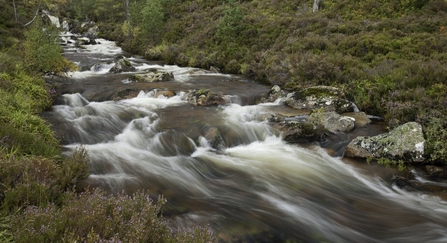
Healthy peatlands naturally filter our drinking water - Mark Hamblin/2020VISION
Approximately 70 per cent of UK drinking water comes from upland peatlands. Yet have you even seen a stream or river whose water is stained brown?
Approximately 70 per cent of UK drinking water comes from upland peatlands.
This is a result of dissolved organic carbon being carried into the water from degraded peatlands upstream. However, in a healthy peatland, all of that carbon is locked up in the peat itself, so the water running off it is clear. This results in the need for much less water treatment, reducing both energy consumption and our water bills.
So, what can you do to protect our peatlands?

One of the most important things that people can do at home to protect our peatlands is to go peat-free in your garden. In the UK alone, nearly three million cubic metres of peat are sold for horticultural use each year, with 70 per cent of that being used by the domestic market. This peat is acquired by draining a peatland, obliterating any traces of wildlife, and then digging it up. All to fill a cheap bag of compost, or to grow on the plants for sale in your garden centre.
In the UK alone, nearly three million cubic metres of peat are sold for horticultural use each year, with 70 per cent of that being used by the domestic market.
Please also consider signing The Wildlife Trusts petition to ban sales of peat and show your support for our peatlands – our amazing superhero habitat!
Sign the petition to ban sales of peat now!


